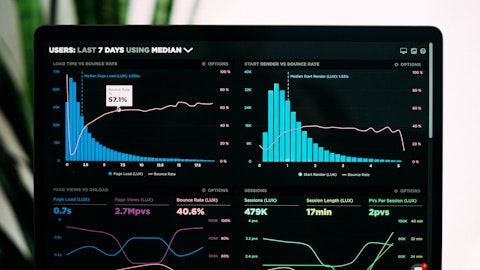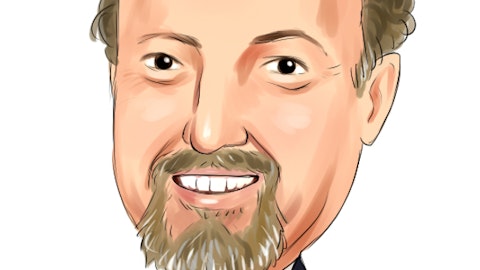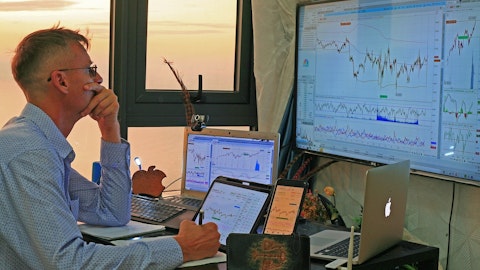RPC, Inc. (NYSE:RES) Q3 2023 Earnings Call Transcript October 25, 2023
Operator: Good morning, and thank you for joining us for RPC, Inc.’s Third Quarter 2023 Financial Earnings Conference Call. Today’s call will be hosted by Ben Palmer, President and CEO; and Mike Schmit, Chief Financial Officer. Also hosting is Jim Landers, Vice President of Corporate Services. At this time, all participants are in listen-only mode. Following the presentation, we will conduct a question-and-answer session. Instructions will be provided at that time for you to queue up for questions. I would like to advise everyone that this conference call is being recorded. Mike will get us started by reading the forward-looking disclaimer.
Mike Schmit: Thank you, and good morning. Before we begin our call today, I want to remind you that in order to talk about our company, we are going to mention a few things that are not historical facts. Some of the statements that will be made on this call could be forward-looking in nature and reflect a number of known and unknown risks. I would like to refer you to our press release issued today, along with our 2022 10-K and other public filings that outline those risks. All of which can be found on RPC’s website at rpc.net. In today’s earnings release and conference call, we’ll be referring to several non-GAAP measures of operating performance. These non-GAAP measures are adjusted net income, adjusted diluted earnings per share, adjusted operating profit, EBITDA and adjusted EBITDA.
We are using these non-GAAP measures today, because we — because they allow us to compare performance consistently over various periods. In addition, RPC is required to use EBITDA to report compliance with financial covenants under our revolving credit facility. Our press release issued today, and our website, contain reconciliations of these non-GAAP measures to operating income, net income, and diluted earnings per share, which are the most directly comparable GAAP measures. Please review these disclosures if you are interested in seeing how they are calculated. If you have not received a copy of our press release for any reason, please visit our website at rpc.net for a copy. I’ll now turn the call over to our President and CEO, Ben Palmer.
Ben Palmer: Thanks. Mike. Thank you for joining our call this morning. As you can see from our earnings release, it was a challenging third quarter. The softness in the period was an air pocket in our business and we believe we responded with appropriate discipline and patience. We currently see a strong improvement in our frac calendar for the fourth quarter. We’re off to a solid start and expect a significant sequential increase in EBITDA to close out the year. In addition, I would highlight that while pressure pumping, our largest service line, drove the weakness, our other service lines demonstrated stable resilient performance. Regarding Spinnaker, our newly acquired cementing business, integration is progressing well, and we were pleased with their financial performance.
And from a long-term strategic perspective, we believe a more diversified business is better positioned to offset potential volatility in pressure pumping or other market dynamics. As we indicated on our last call, in the face of competitive pricing pressure, our bias was to idle assets. This soft pricing environment was driven by lower oil prices during the second and into the third quarter, which caused several of our customers to delay completion. While there were near-term cost absorption impacts for idling assets, we think this was the right call. Discipline and financial conservatism underpin our ability to deliver sustainable cash flows over full energy cycles. Pricing remains competitive in the spot market, where we primarily participate, and we have given some concessions.
However, our fourth quarter pricing is expected to be more attractive than the temporarily low levels in the marketplace during the third quarter. Further, not participating in projects at particularly low pricing and margins can extend the life of our equipment, push out maintenance and repairs, and maximize the lifetime return of our assets. Bottom line, as it looks now, our fleet should be well utilized in the fourth quarter, which is again consistent with our comments in July. We began removing some costs late in the second quarter and early in the third quarter. However, as calendar visibility and market dynamics improved, we decided to limit workforce reductions. We began to hire back employees to position ourselves to be service ready and capitalize on the rebound in fourth quarter activity.
Overcorrecting on costs might have left us unable to meet current demand. Although we do not provide financial guidance, I can offer you a directional comment in light of our third quarter results. We think fourth quarter results are likely to look more like second quarter than third quarter. I’ll caveat that by saying that that’s our current view, which is, of course, subject to unpredictable market shifts and currently anticipated minimal holiday slowdown. Mike Schmit, our CFO, will now discuss the quarter’s financial results. And after that, I’ll have a few closing comments.

Mike Schmit: Thanks, Ben. I’ll start with the third quarter 2023 sequential financial overview. Third quarter revenues decreased to $330.4 million from $415.9 million in the prior quarter. This was largely driven by the decrease in pressure pumping activity, as Ben discussed. The following is a breakdown of our revenue percentages for the third quarter for our top service lines. Pressure pumping was 33.5%, downhole tools was 29.1%, coiled tubing was 11.1%, cementing was 8.1%, rental tools was 6.1% and nitrogen was 3.7%. Cost of revenues, excluding depreciation and amortization, during the third quarter also decreased to $239.1 million from $265.8 million. As a percentage of revenues, cost of revenues in the third quarter was 72.4% compared to 63.9% in the prior quarter.
Selling, general and administrative expenses decreased to $42 million in the third quarter of 2023 compared to $43.6 million in the second quarter. This decrease was due to a settlement charge of $4.5 million that was paid out at the beginning of Q2, which was offset by some incremental SG&A from the acquisition of Spinnaker. Operating profit during the third quarter decreased by 72.4% to $22.7 million from $82.4 million in the prior quarter. Adjusted operating profit was $22.7 million in the third quarter, a 72.7% decrease compared to $83.3 million in the prior quarter. Adjusted EBITDA also decreased by 52.9% to $51.9 million from $110.1 million in the prior quarter. Our technical services segment revenues decreased 22.3% to $303.1 million, and segment operating profit decreased to $18.9 million from $77 million.
Our support services segment revenues increased 5.8% to $27.3 million, and segment operating profit decreased to $6.9 million from $7.9 million. I’ll now discuss our capital expenditures. Capital expenditures were $44.3 million in the third quarter. We currently estimate full year 2023 capital expenditures to remain between $200 million and $250 million, excluding the purchase of Spinnaker. As a reminder, we are also expecting to receive a US Federal tax refund of approximately $47 million in the first quarter of 2024. I’ll now turn it back over to Ben for some closing remarks.
Ben Palmer: Thanks, Mike. To wrap up, the quarter really boiled down to one key element, a temporary lull in our pressure pumping business, driven in part by our decision to idle assets until pricing and activity conditions improved. As we stand today, we are currently encouraged by improved market dynamics and expected fourth quarter pricing and utilization. This view is supported by heightened activity among privates, especially in the Permian Basin, where we are well positioned to capture incremental demand. As you know, increasing the capital discipline among large EMPs can create opportunities for smaller companies. And if oil remains comfortably above $80, we and our customers should have a favorable near-term operating environment.
Shifting to capital allocation. Our healthy, debt free balance sheet is key to maintaining financial flexibility and strategic optionality. We successfully added an attractive business this year with the cash acquisition of Spinnaker, and our Board of Directors just approved our regular $0.04 per share quarterly dividend. With respect to capital investments and trends of newer pressure pumping technologies, I would again say we will take a conservative and disciplined approach. While there is increasing customer interest in the use of alternative fuels to operate equipment, we will prudently invest in a transition of our equipment when justified. Furthermore, I would like to reiterate, while we will replace older equipment, we do not intend to add pressure pumping capacity to an already competitive marketplace.
While we operate an often volatile market, our approach and strategy will remain consistent with a focus on financial stability and long-term shareholder returns. Lastly, we’d like to thank our employees for their continued dedication, staying focused during a difficult operating environment, working on our digital transformation programs, and helping with the integration of Spinnaker into our company. Thanks for joining us this morning. And, at this time, we’d be happy to address any questions.
Operator: Thank you. [Operator Instructions] We’ll take our first question from John Daniel at Daniel Energy Partners.
See also 12 Best Clean Energy Stocks To Buy According to Wall Street Analysts and 14 Best Bear Market Stocks To Buy Now.
Q&A Session
Follow Rpc Inc (NYSE:RES)
Follow Rpc Inc (NYSE:RES)
John Daniel: Hey, guys. Thank you for including me. [I need] (ph) your tax guy, by the way. There are a ton of — as you guys know, there’s a ton of small operators in the Permian, a lot of whom run a rig for short term programs and I presume some of those people don’t — obviously, they wouldn’t have enough work for a dedicated crew, so the rise in spot services. I guess — and knowing that you just said Q4 is better, but can you speak to your visibility into the demand from these, what I may call, micro-operators for next year? Just — do you see them, many of them seeking to add rigs and then eventually need a frac crew at 2024? And then just how quickly do you think that spot market could tighten next year?
Ben Palmer: Yes. John, this is Ben. Or, Jim, do you want to take that?
Jim Landers: Yes. Let me at least start, John. Good question. Good question, because we are in the spot market and the idea would be that if these smaller operators start working again, they don’t have the wherewithal to get a dedicated crew and that’s kind of where we try to play. Some of the small companies that have been purchased over the past year are coming back in. We know a couple of examples. They’ve got to get the management groups together and get capital that’s easier and faster at $90 oil than $70 oil. So, on the other side of it, there are people who might be hesitant. We think there might be similar spot customer trends as what we’ve seen in prior years, adding rigs incrementally. But, you know, your question is really about visibility.
We probably lack a visibility — we probably have a lack of visibility, because these smaller players make plans and add rigs quickly. And so, that’s good. It’s good to do it quickly. But it doesn’t necessarily tell us that in February of 2024 we’re going to have some great spot work coming up. A lot of these operators, as you know, as we all know, only operate about one rig at this point. So, anyway, that’s I think part of and perhaps most of the answer we have for you today. I don’t know what Ben and Mike might want to add.
Ben Palmer: I’ll add, John. It’s a very good question. And, yeah, we talk a lot about and people talk about spot market and not spot market, right. It’s not black and white, right. We don’t work just for what some people would term spot customers. When you talk about somebody who has a rig or less than a fully equivalent rig for a full year, if we’re working for them, we’re working for them for a few weeks. There are some customers, a lot of which — a lot of our businesses come from customers that we work on for several months, right. And then there are the larger players and there are many fewer of them, they do comprise a half or so of the market in the Permian that are typically willing to sign a year plus contract. And we’ve worked for some of those folks. But we tend to focus on, and we’re most well positioned to work for the spot market players and what we call kind of the partially dedicated players, right.
John Daniel: Right.
Ben Palmer: So, spot market being people that we work for a few weeks, then there are a lot of customers and a lot of work for customers we can work for a few months. And then a lot of the big players that are operating 10 plus rigs. They are the ones that want a lot of the technology that everybody talking about in terms of energy, fuel delivery alternatives and things like that. And we don’t own that technology. We’re not developing that technology. We’re not investing today significantly in that technology. But that’s half the market, right. So, there’s half the market that we’re certainly very well positioned to work in and have worked in. And we’ll be working in with those players in the fourth quarter and into 2024. So, there’s a lot of work.




